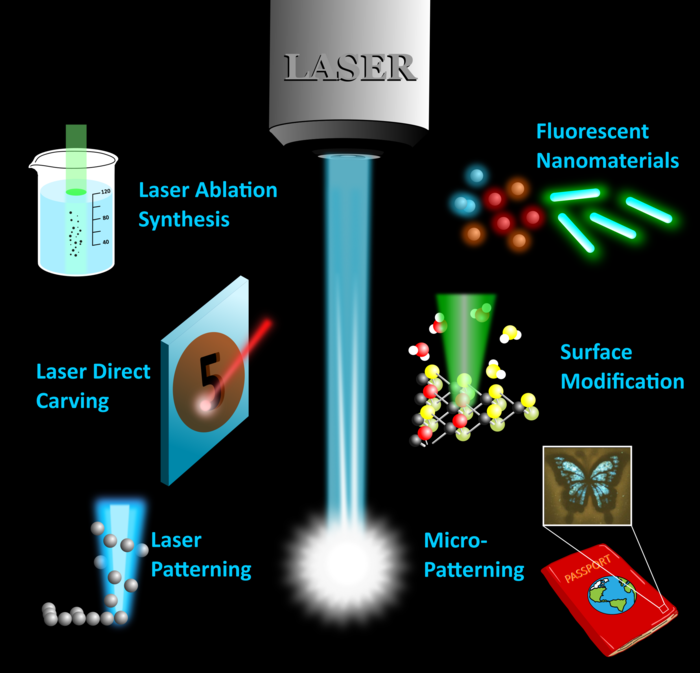The extensive lineage of laser-based operations has made a significant contribution to the production, modification and patterning of numerous nanomaterial systems over the years.
 Representative laser operations and application outcomes from laser induced fluorescence functionalization of nanomaterials. Schematic abstract of review layout. Left. Representative laser techniques discussed in the review, comprising laser driven synthesis of nanostructures from thermal ablation of precursors in solutions, laser direct writing through laser initiated redox or combustion at nanomaterial surface, and spatial patterning of nanomaterials through optical gradient and radiation forces at the laser beam waist. Right. Corresponding outcomes from the various laser processes, including the formation of diverse range of fluorescent nanomaterials with refined control in composition and dimensions, and spatially refined surface modifications that result in superior color tunability and micropatterning. Image Credit: Eng Tuan Poh, Sharon Xiaodai Lim, Chorng Haur Sow.
Representative laser operations and application outcomes from laser induced fluorescence functionalization of nanomaterials. Schematic abstract of review layout. Left. Representative laser techniques discussed in the review, comprising laser driven synthesis of nanostructures from thermal ablation of precursors in solutions, laser direct writing through laser initiated redox or combustion at nanomaterial surface, and spatial patterning of nanomaterials through optical gradient and radiation forces at the laser beam waist. Right. Corresponding outcomes from the various laser processes, including the formation of diverse range of fluorescent nanomaterials with refined control in composition and dimensions, and spatially refined surface modifications that result in superior color tunability and micropatterning. Image Credit: Eng Tuan Poh, Sharon Xiaodai Lim, Chorng Haur Sow.
With the widespread use of fluorescent nanomaterials in a variety of niche applications (micro-encryption, bio-tagging, photonics), the ability to manipulate fluorescence properties with a focused laser presents a huge opportunity for material science and physics research.
A team of researchers headed by Professor Chorng Haur Sow of the Nanomaterials Laboratory in the Department of Physics at the National University of Singapore assessed the vital influence of various laser-based techniques on the fluorescence properties of a variety of nanomaterials. The study was published in the Light: Advanced Manufacturing journal.
The review covers a wide range of laser techniques, including laser ablation, direct laser writing, hybrid patterning and microprinting, as well as the corresponding fluorescent nano-systems that use defect or dopants-based emission and redox-induced fluorescent states.
The researchers analyzed laser-assisted control in fluorescence properties at the nanomaterial production stage, starting with a segment on laser-induced fluorescence. The control in nanomaterial dimension and composition offered versatile tunability in the fluorescence colors of the synthesized nanomaterials with the involvement of the laser’s photonic input at the material synthesis process.
The experts also developed nanomaterials with fluorescence that can be activated by laser post-modifications, resulting in compositional changes and defects as origins for the initiated fluorescence. The section concentrated on scenarios in which the laser converts non-fluorescing precursors to fluorescent forms.
The subsequent sections of the review analyzed examples where the laser changes the fluorescence features or spatial resolution of a nanomaterial that was originally imbued with fluorescent properties.
The potential for on-demand, high-resolution adjustments of the material fluorescence post-synthesis afford great potential in understanding the nanomaterial chemistry and exciton physics at work, using the laser as an optimal handle to fine-tune the nanomaterials’ emission colors and spectra.
Furthermore, quality micropatterns and encryption technologies can be provided with high color and spatial quality using laser-refined spatial resolution in the implantation of fluorescent nanomaterials.
The review, which is divided into three sections: laser-induced fluorescence, laser-modified fluorescence, and laser-assisted patterning, covers a wide range of cutting-edge laser technologies applied to a variety of nanomaterial variants, each with its own fluorescence origins.
In light of this, researchers are optimistic that, “the ever-increasing attention on the convenience of laser tuning of nanomaterial properties would favor the timely delivery of this review as a holistic summary that would prompt the next generation of laser operations for advanced functional nanomaterials.”
Evaluating the significance of lasers in the advancement of materials engineering and fluorescence photophysics, they added, “with the focused laser beam, we can induce localized, microscale reactions that unravel intriguing physics phenomena with extensive engineering control over the nanomaterial performance. This allows enhanced mastery over desirable material properties while unlocking greater scientific understanding over the exotic mechanisms at work.”
Journal Reference:
Poh, E. T., et al. (2022) Multifaceted Approaches to Engineer Fluorescence in Nanomaterials via a Focused Laser Beam. Light: Advanced Manufacturing. doi.org/10.37188/lam.2022.004.